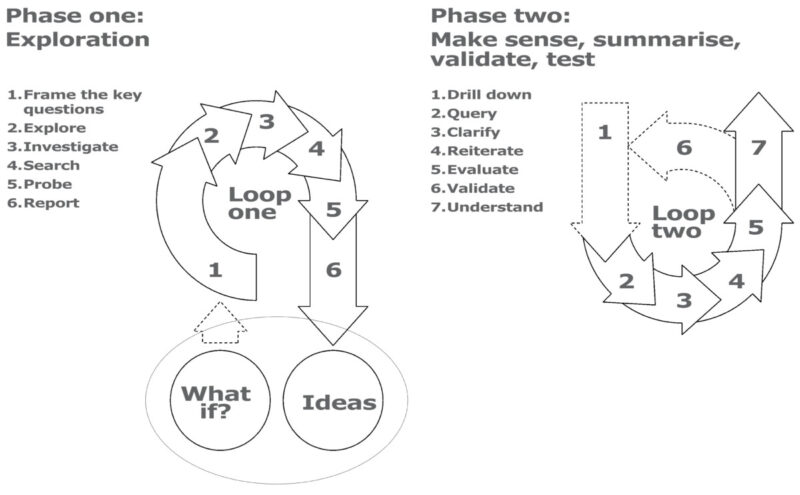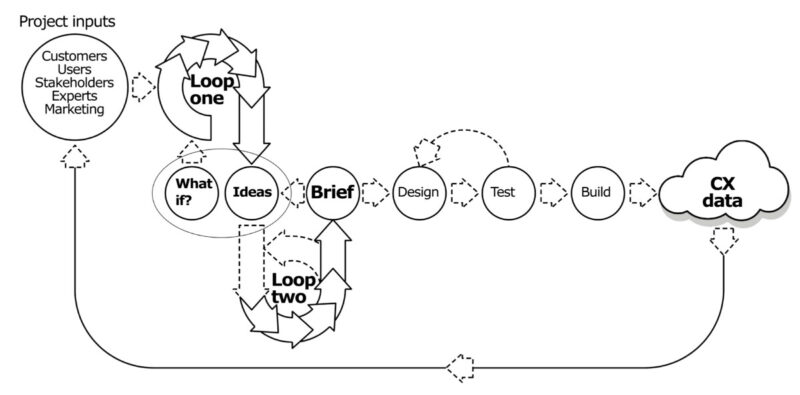The future’s better buildings will be briefed “beyond the building” via the connected intellect

Download a printable version of this page here
The future’s next step beyond standard building design briefing
This is how the connected intellect offers a way of communicating with key customer audiences via the web to help you understand and deliver more precisely what they want, to minimise risk by delivering a superior property product, and to improve their beginning-to-end customer experience (CX)
It’s time to think differently about competition in commercial property’s future
Although we may still be in the earliest years of the internet, every mind at every desktop, and in every property user community, is now better connected than ever before.
The connected intellect is our path to the collective imagination;
the collective imagination is our path to our future.
And through it, we now have available to us the most powerful and naturally occurring human force ever created, through whose precision those minds can be steered to deliver an unprecedented understanding of the needs and preferences of any group of building customers and users.
For the first time in history, the connected intellect, with its formidable and abundant capacities, allows us to design our buildings around the intelligence and sensitivities of those who will benefit from them.
The connected intellect is our path to the collective imagination, and in property, the collective imagination is our path to our future.
But, although our solution may be unique, we are not alone in this awareness, of course.
The fact that, at minimum, two of Australia’s very largest developers and owners of commercial property now employ managers with “customer experience” in their titles offers one indication of how, through digitisation, the marketing landscape for commercial property in Australia is evolving to bring its providers closer to customers.
The most formidable of your future competitors will be the business best able to mobilise that most potent resource in its business and customer base, guided by better data, at speed. Its threat to your own will lie in it having learnt quickly how to work with and grow that collective intelligence.
And in this, the resource to put to work in designing a better business and products – the connected intellect of the post-Facebook mind – is already present and at work at every desk within your own and every rival’s business.
Making sense of how to make it work for demonstrable competitive advantage is every property provider’s great challenge.
Remove guesswork and trust in instinct alone to provide a better property product
In this contest, in the connected, digital age, the approach we describe here to strike back against those big guns, while unique and borne of first-hand experience, is also obvious and of its time.
And, naturally, delivering a superior built outcome can only benefit from taking a project’s bird’s-eye, end-to-end view, and securing a better quality of information upstream from actual users as an early design input.
As architects, our goal, as yours, is to use the collective intelligence the connected intellect affords to create and configure buildings that will perform better in every dimension that matters most to those who will pay for, invest in and live, use and work in them.
The clarity-enforcing precision of the two key investigative steps below makes it possible to make sense of the diverse perspectives that must come together in a brief capable of delivering those better properties of the future.
Their powers for sense-making and checking will enable you to create designs that can be tested to fit and perform better for your business.
Because it is proven by centuries of use, this process’s most successful users will also be those developers most likely to produce a superior CX, to manage their risk best, and so to improve their ROI.
Critical learning comes in two simple loops
With this dependable, double-loop briefing process, you can build new value from what your people and your customers know.
Until it is harnessed, the idea of capturing a workplace’s knowledge, let alone that of a customer base, sounds potentially chaotic and messy, which it is. However, making sense from a cacophony of competing voices and opinions is no different to the challenge faced by news organisations reporting around the world every day.
As such, our solution isn’t rocket science, but a communication process proven both by our own repeated personal experience of written reporting and sense-making over many years, and by hundreds of years’ of practice by others.
Its goal is to document for those involved the information they require in a consistent, reliable fashion, such that they can drill down into this resource to keep on refining their approach to getting from it what they need when they need it.
Our briefing process therefore follows the diagrams beneath, using sense-making rules that apply to all publishing of professional quality.
Loop one
Depending on the question put to it, the first loop’s aim is to fish for possibilities, ideas and insights, based on what is believed, known and experienced by the exercise’s target group.
From what its members submit, at the end of this loop, a broad, outline report is generated.

Loop two
In the second loop, this report is held up for scrutiny and questions are asked to verify meaning and intention, in order to guide the development of the interrogation.
This is the critical stage in which new revelations occur.
Once exposed to a group whose prior perspectives – and possibly, even its members – were previously unknown to each other, its purpose is to elicit comment by sparking new and unexpected insights to build upon what is known collectively by its participants.
It is to summarise, and, through reiteration and clarification, create a platform for subsequent interrogation, in plain English.
In professional media production, rule number one is that every writer needs a second reader to check facts and to ensure what is written can be understood.
Unchecked, imprecisely written material, possibly in great volume, is of no help to anyone. Making complete, concise sense is critical if decisions are to be made.
Feedback loops enforce better product quality, planning, learning and returns across the entire building lifespan
Where questions remain, such as at briefing, or at design testing, as illustrated, checks and feedback loops afforded by briefing via connected intellect allow for errors to be picked up and corrected a long time upstream of construction, minimising risk and optimising output, according to project constraints of budget, time and quality.

What is the post-Facebook connected intellect that makes briefing via a range of key diverse inputs possible?
Previously, it used to be hard, if not impossible, to capture and transform into usable information the knowledge and insights of those across any organisation.
Yet, as our familiarity with using the social internet grows, we have reached an age of unprecedented opportunity in making the best use of intelligence across web-connected communities and businesses.
Although it is still a force unrecognised, unexamined and therefore unorganised in most organisations, through near-ubiquitous familiarity with Facebook and others, we’ve now arrived at “peak social internet literacy.”
This entirely naturally occurring capacity’s practical applications are also easily demonstrated, as we have reached the point at which every employee in every business knows how to use social media to write online, upload and share material and to make comments about those items uploaded by others.
And when such communications are in writing and captured by the mirroring, private, internal Facebook-like or networked, document-sharing technologies now available within every business, workplace knowledge, insight and learning that was once out of reach is no longer beyond management’s grasp.
It also has access to a bottomless, renewable resource – an inexhaustible source for possible business and customer experience-improving investigation – whose creativity may be limited only by its imagination.
And, through it, we can build a far superior understanding with which to manage, investigate and experiment.
The professional challenge now lies in inquiring, making sense of and feeding back to this group with diverse opinions what its members know and can contribute to understanding how to create superior property and purchasing processes.
Property’s future will be built inside the minds of customers
From a “knowledge architecture” point of view, any property creates an opportunity to build a better understanding of uses and users, in order to develop new understanding of how to satisfy its target audience’s need, and therefore how to attract others like it.
By removing guessing and, as illustrated, “briefing beyond the building” to reduce risk and to understand customers better to get closer to them simply makes good business sense.
Briefing by tapping into the available connected intellect enables property providers to climb inside the minds of “knowledge communities” to develop the most appropriate and best-fitting combinations of products and services.
Showing commitment to the buyer or user relationship by demonstrating an intention to uphold product and service quality – however the customer perceives it – is straightforward QA, and makes simply for smarter marketing.
Get closer to customers to reduce property risk, grow value and ROI
Because the power of the human imagination is not going away, we have an opportunity to do much more than simply adapt.
Instead, we need to engage the formidable collective intelligence to which the connected intellect gives us access to invent better products and processes, and to prepare for a future none of us can yet see, but which will inevitably be built on it.
Most immediately, that collective intelligence can sharpen the return on any property by making sure designs work before they are built, by reducing speculation and waste, and by finding ways to remove barriers to improve every process in their planning and construction.
Even such practical issues notwithstanding, we believe briefing via the connected intellect has a big future because, at minimum, it simply adapts long-standing qualitative market research practices to the emerging needs and idiosyncrasies of property customers.
Property, like all other businesses touched by the internet, is now also becoming an information business, and feeding CX data upstream into the planning mix now offers the most direct, economic and least risky route to sustained feedback, focused customer and user-community happiness.
We believe strongly that this is the future, and by using it to capture an end-to-end view, we, as architects, aim to design from the intellect up, working with dimensions other architects cannot yet see.
We are now keen to ensure our clients can gain advantage from learning how to use this new focus well.
Those who achieve this will likely also benefit from the distinctive branding, reputational differentiation and business growth it can bring by helping them be seen to engage thoughtfully and appropriately with enduring customers over the long term.
When everyone’s future CX competition is so clearly cut out, why would anyone else bet against the persistent human ingenuity and power of the connected intellect?
For more, contact Graham Lauren: 0416 171724 or via graham@shiroarchitects.com. #connectedintellect
